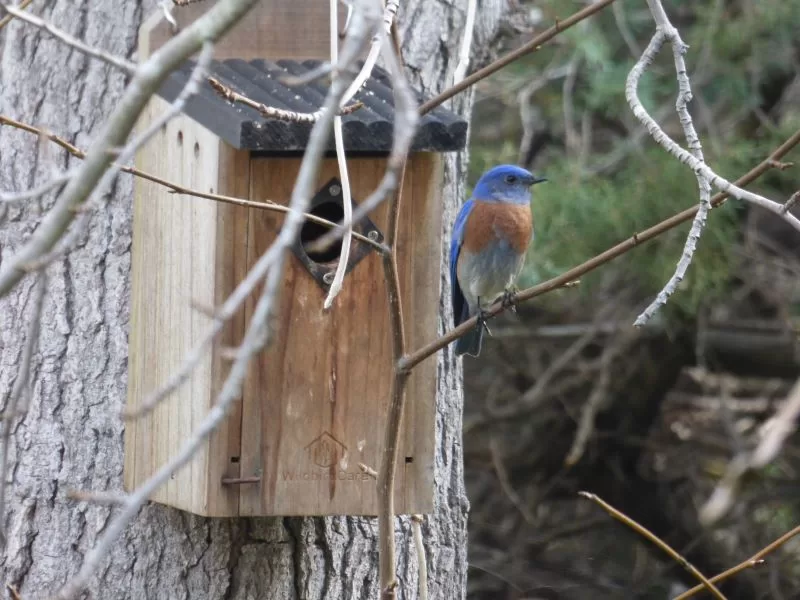
As long as there are bluebirds, there will be miracles and a way to find happiness.
– Shirl Brunnel, I Hear Bluebirds, 1984
Why are blue-colored birds a traditional sign of good fortune in so many cultures, worldwide? Homespun American philosopher Henry David Thoreau may have had the answer: “The bluebird carries the sky on his back,” he wrote.in a letter to a friend. Bluebirds are the color of the sky, of heaven—a shade that is rare among terrestrial plants and animals.
Thoreau was referring to the Eastern bluebird, Sialia sialis, one of three members of the genus sialia—North American songbirds in the thrush family that are officially known as “bluebirds.”
In Iroquois mythology, the song of the bluebird vanquishes the fearsome spirit of winter, Tawiscaron. To the Hopi, these birds are sacred messengers.
A song about the mountain bluebird is part of the Navajo Ye’iibicheii winter Nightway ceremony, sung just before the sun comes up. In 1975, Singer Lena Clark made a recording of it for a New World Records album entitled Navajo Songs from Chinle, and Canyon De Chelly, Arizona. The translation is simple: “Bluebird said to me, ‘Get up, my grandchild. It is dawn, it said to me,” but its meaning is deeper. This is a hymn to the sun, to the importance of being in balance with the universe.
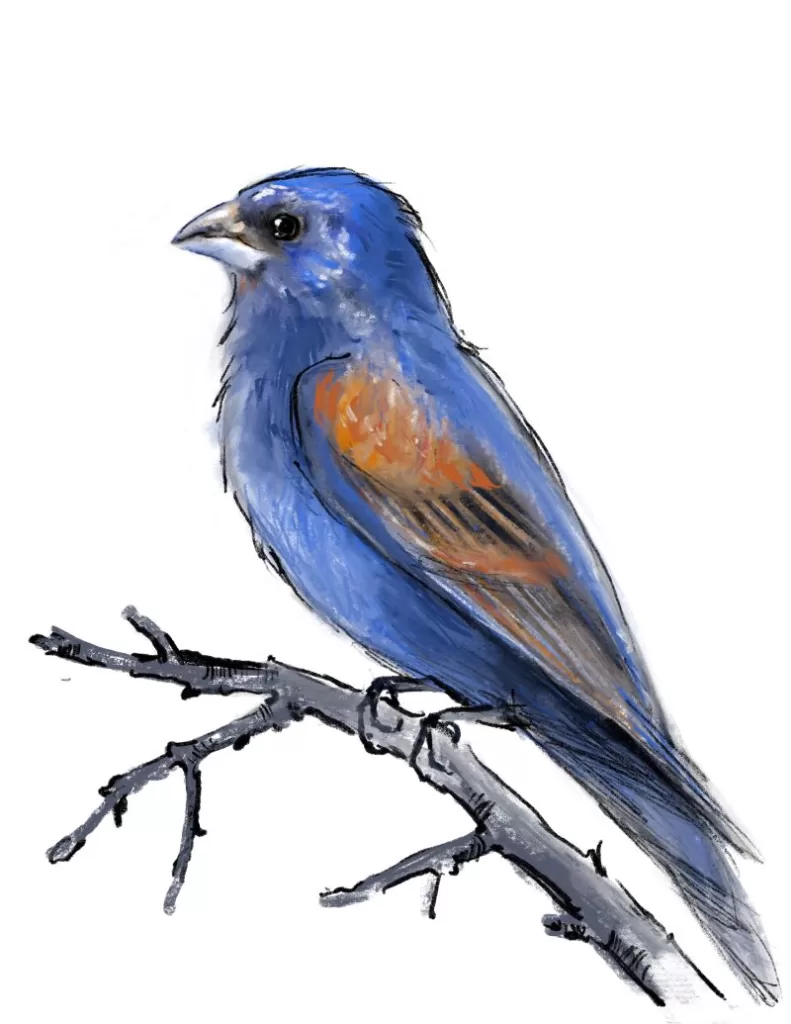
Sialia currucoides, the mountain bluebird, is not common in the Santa Monica Mountains, but it is sometimes seen here. The male is a pure, heavenly blue. Sialia Mexicana, the Western bluebird, is the more abundant bluebird in the Santa Monica Mountains. The male of this much-loved species has a royal blue back and wings, and a red breast with white feathers underneath. The female is more gray and pink than blue and red.
These North American bluebirds have become synonymous with the mythical “bluebird of happiness,” but that tradition has deep roots and a complex history. Chinese art and folklore contain depictions of blue and green birds known as “Qingniao”, the messengers of the mother goddess Xi Wangmu, the Queen Mother of the West. In art, these birds often resemble peacocks; in literature, they are sometimes described as crows.
The peacock, with its brilliant blue-green feathers, is an ancient symbol of immortality and divine protection in its native India. Lord Krishna is often depicted with a peacock feather as a protective talisman in his crown. The peacock’s beautiful plumage and ease of domestication made it a desirable trade commodity throughout the ancient world. When they arrived in Greece, they became sacred to Hera, the Greek goddess of marriage and motherhood. She used the peacock’s “eye feathers” to keep watch on her devotees and also on her husband, the god Zeus. Long after Hera and the rest of her pantheon had given way to the Christianity, the peacock continued to symbolize paradise and immortality.
In ancient Egypt, blue is the sacred color of the afterlife. Bennu, the great blue heron, is the keeper of the soul of the sun god Ra. In Central America, the Aztec people prized the turquoise-green and blue feathers of the Quetzal and Cotinga bird, symbols of heaven and divinity.
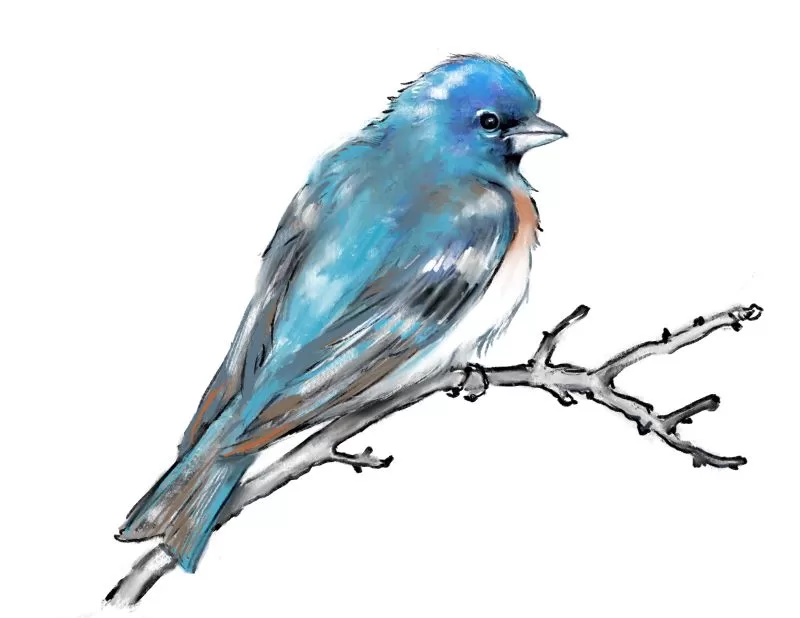
The Western idea of a “bluebird of Happiness” is said to have originated in the folklore of the Lorraine region of France. It was popularized by Belgian symbolist writer Maurice Maeterlinck in his 1908 play L’Oiseau bleu. In the story, two children seek this elusive and magical creature, only to find it in their own hearts after an act of selfless generosity when they return home empty-handed.
Europe doesn’t have a native member of the silas family, but it does have the barn swallow, whose graceful shape, distinctive forked tail, and iridescent dark blue feathers have found their way into mythology. This is the blue bird that appears as a decorative motif on everything from jewelry and tattoos to dinnerware and wallpaper.
Long before Maeterlinck wrote the Blue Bird, Hans Christian Anderson romanticized the swallow in his tales. This is the bird that Thumbelina saves and who later rescues her, and carries her to safety.
Blue willow, a china pattern inspired by ceramics and motifs found on actual Chinese porcelain, tells the story of lovers transformed into birds. Although the author of the story describes them as “turtle doves” they are almost always depicted with the forked tails of the barn swallow.
Maeterlinck’s fictional bluebird of happiness finds its way into songs like the 1934 “Bluebird of Happiness, by Sandor Harmati, with lyrics by Edward Heyman and Harry Parr-Davis:
So be like I, hold your head up high
Till you find a bluebird of happiness
You will find greater peace of mind
Knowing there’s a bluebird of happiness.
And the 1941 song White Cliffs of Dover, by Walter Kent, with lyrics by Nat Burton:
There’ll be bluebirds over
The white cliffs of Dover
Tomorrow, just you wait and see.
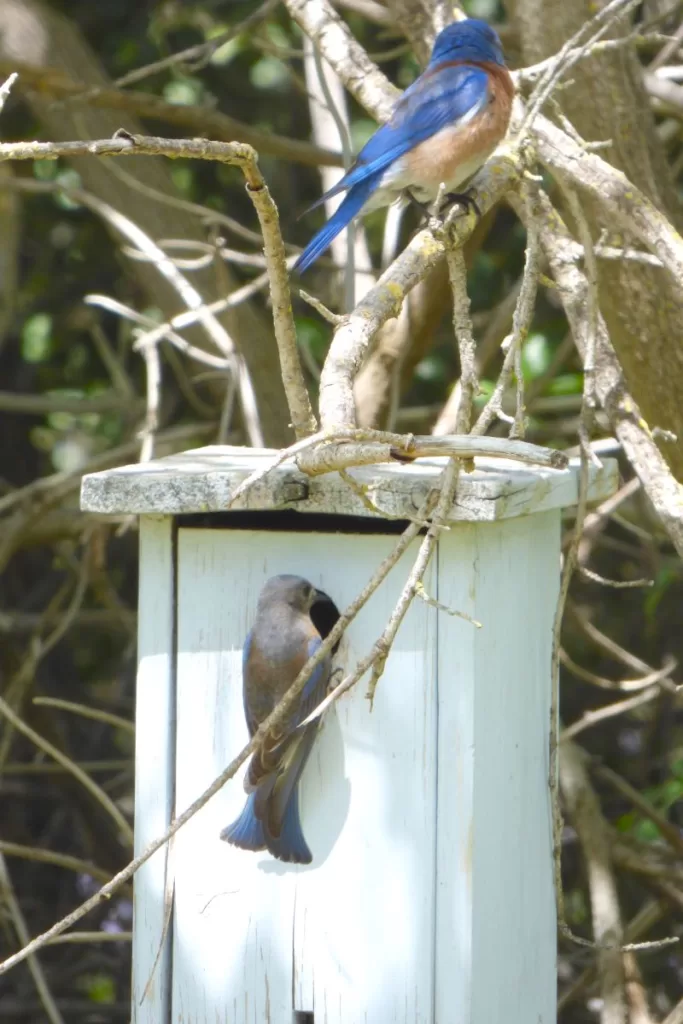
The former was intended to instill hope during the Great Depression; the latter, as a promise of hope during WWII in Britain.
While this mythical bird is cherished as a good omen, human activities placed the bluebird and everything it represents in peril in the twentieth century. Exposure to the pesticide DDT, combined with rapid, extensive habitat loss, and competition from invasive non-native species like the house sparrow drove the native American bluebirds to the edge of extinction in many areas. Their recovery is a conservation success story, one driven by grassroots activism. Environmental protections that include getting DDT out of the food chain and conserving key habitat has given these birds a chance to survive. Conservationists using networks of nest boxes, called “bluebird trails” have had success reintroducing the birds to areas where they had become locally extinct. Bluebirds are fearless around humans and happy to take advantage of backyard nest boxes. Providing the right kind of boxes and ensuring that backyards offer shelter and an uncontaminated food supply have been key to this conservation success.
The local population of Western bluebirds has fared better than more urban Southern California populations, because more of this species’ natural habitat is available, but that habitat is increasingly fragmented and impacted by development and climate change. Western bluebirds need old-growth trees with natural cavities or abandoned woodpecker holes to nest in, and wildfires like the catastrophic Woolsey Fire, as well as indiscriminate tree removal make the fate of this beautiful bird uncertain in the local area. Federal, state and local agencies have stepped up, installing nest boxes at local parts, including King Gillette Ranch, owned by the Mountains Restoration and Conservation Authority, and the City of Malibu’s Charmlee Wilderness Park, where boxes destroyed in the Woolsey fire have been replaced and are being monitored.
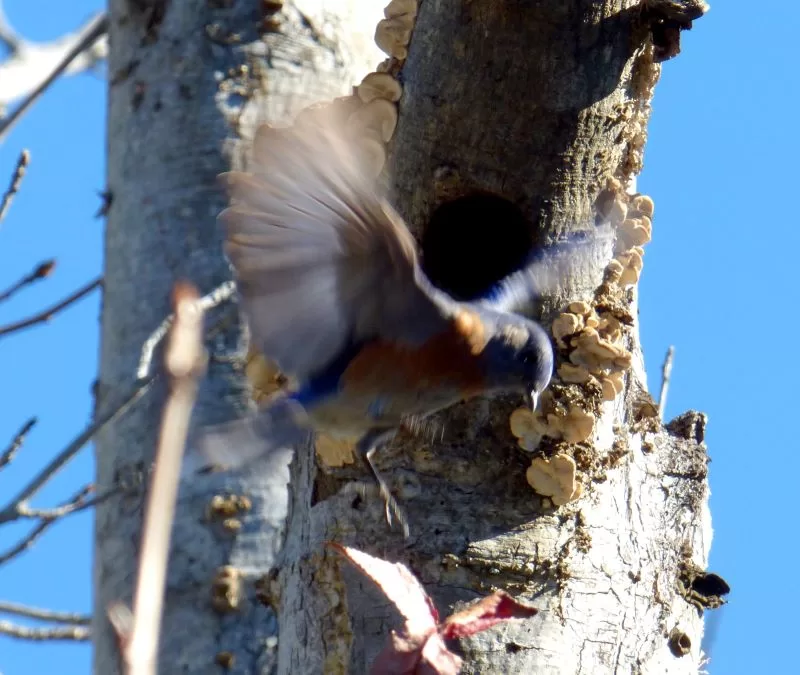
Fifty years ago, seeing a bluebird in the Santa Monica Mountains was a rare thing. Today, they are back, bringing a welcome flash of blue feathers to the garden.
Adding a nesting box to the garden may attract bluebirds. Boxes designed especially for bluebirds are widely available, and may also attract other cavity-nesters like the oak titmouse and the bewick’s wren. It is important to ensure that the garden is safe for birds. Keep cats away from nest boxes and birdbaths. Avoid using pesticides—bluebirds depend on an ample supply of caterpillars to raise their young. Even so-called “earth-friendly” pesticides can impact their food supply. It’s also important to avoid using netting in the vegetable garden or orchard, to prevent potentially fatal entanglements.
Seeing the flash of a bluebird’s bright wings in the garden, or hearing its distinctive song (a staccato refrain of “I don’t know/I know.”interspersed with calls of “who, you?” or maybe “phew! phew!”) is a true source of happiness. So is knowing that these beautiful birds that carry the sky on their back are making a successful comeback, and that we can help ensure a strong future.
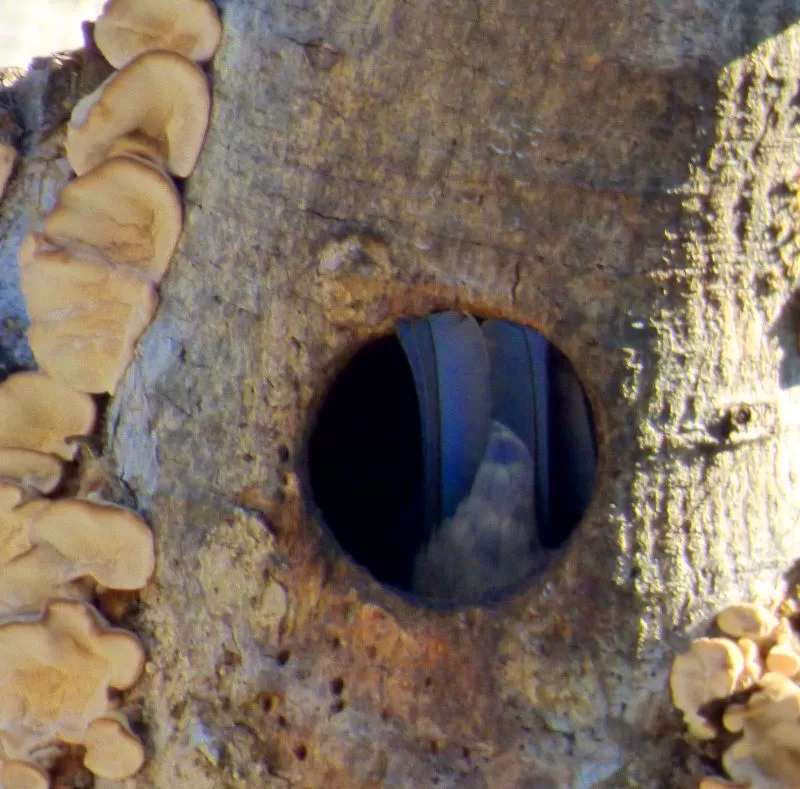
More Blue Birds
Bluebirds aren’t the only blue-colored birds in the Santa Monica Mountain Mountains. That flash of blue in the garden or on the hillside could indicate the presence of any of several other blue-colored bird species.
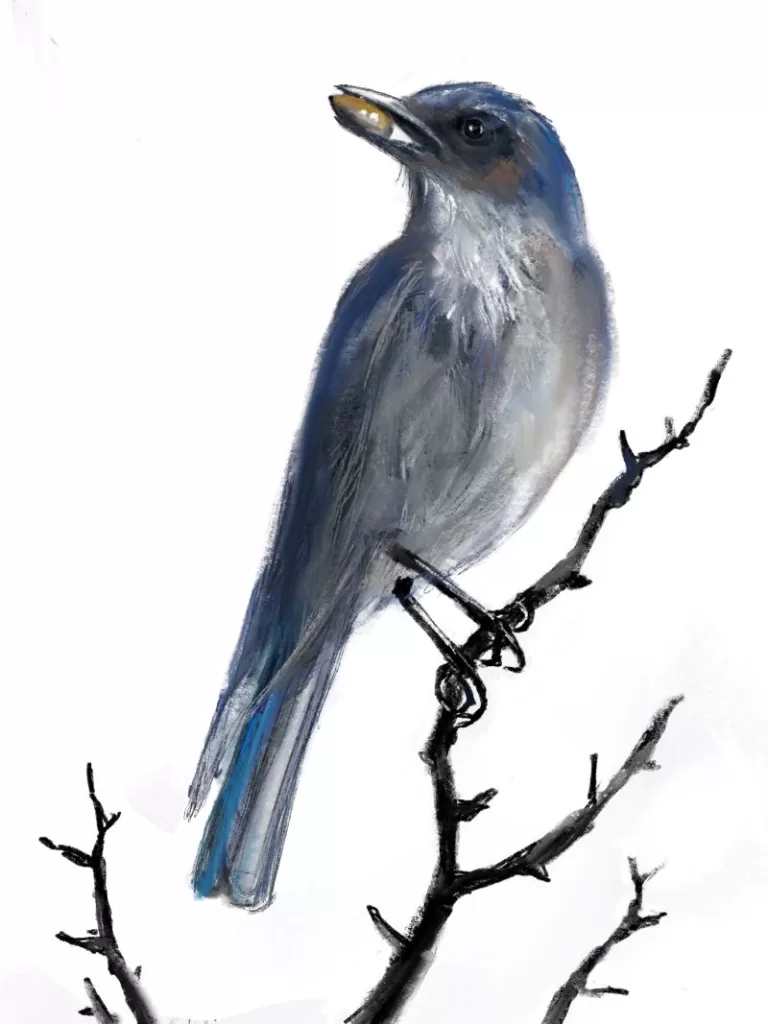
The California scrub-jay, Aphelocoma californica, is the smartest, boldest, loudest, blue-feathered bird in this area. It’s a member of the crow family, which accounts for its intelligence and audacity. Males and females both have showy blue feathers. This is a fearless, clever garden resident, the one who figures out exactly when the bird feeder is filled and comes and taps on the kitchen window when breakfast isn’t served on time. Scrub jays can be seen dive-bombing hawks and bigger crows and the neighborhood cat. They’re often responsible for the oak seedlings that sprout from the pots on the patio or the middle of the lawn—snacks that were carefully hidden and never retrieved. They aren’t sweethearts, and will raid the nests of other birds for eggs and nestlings, but they are an integral part of the local ecology, and a charismatic presence in the garden. are smart, sassy and determined.
The blue grosbeak, Passerina caerulea, has deep blue feathers, red-trimmed wings and a conical beak that resembles a nutcracker. It arrives from its winter feeding grounds in Mexico in the spring to breed in open oak woodland in the local mountains. Male and female jays and swallows have the same coloring, but only the male grosbeak is blue, the female is a sedate red-brown. The blue grosbeak is not a common bird, and it is more often heard warbling from the treetops than seen, but it is a successful one whose range and population appears to be increasing as it learns to adapt to urban life.
The lazuli bunting, Passerina amoena, has markings that are similar to the bluebird’s, but with sky blue feathers. Lazuli buntings are a close relative of the blue grosbeak and have a similarly impressive beak. Like their grosbeak cousins, the bunting’s population has remained relatively stable over the last 50 years, even trending slightly upward, according to the International Union for Conservation of Nature’s Red List. This is another bird that is more often heard singing than seen, but lately, Lazuli buntings are more in evidence than usual in the Santa Monica Mountains. These blue birds really are an auspicious sign, because they thrive in chaparral habitat that has burned and is recovering. Their presence in the Woolsey Fire burn area is evidence of the restorative power of nature. Lazuli buntings can hybridize with another close relative, the indigo bunting, Passerina cyanea,which is a deep pure blue. Indigo buntings are occasionally spotted in the Santa Monica Mountains, but aren’t common.
The barn swallow, Hirundo rustica, is a widespread species. They aren’t as common in the Santa Monica Mountains as they are in more urban areas, because this is a species that long ago learned to take advantage of human activities, but they do nest here, under the eaves of houses and sheds, under bridges and any other manmade structure. These acrobatic fliers have the distinctive blue coloring and forked tails of the birds on the “blue willow” pattern. They are a traditional harbinger of spring, traveling north to nest in early spring.
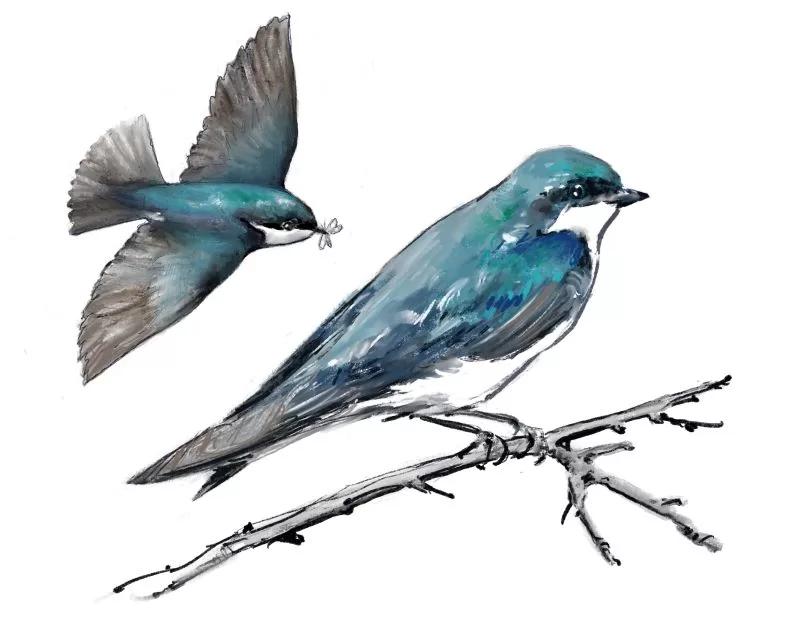
The tree swallow, Tachycineta bicolor, is also a vivid vibrant blue green. This is a more compact swallow than the barn swallow, and its iridescent feathers can appear either green or blue depending on the light. Like western bluebirds, tree swallows are cavity nesters and they, too, will take advantage of nest boxes, and reward their human neighbors by eating pest species insects like mosquitoes as well as with the happiness that comes from seeing a glimpse of brilliant blue features in the garden or on the wing, heavenly messengers with the sky on their backs.












